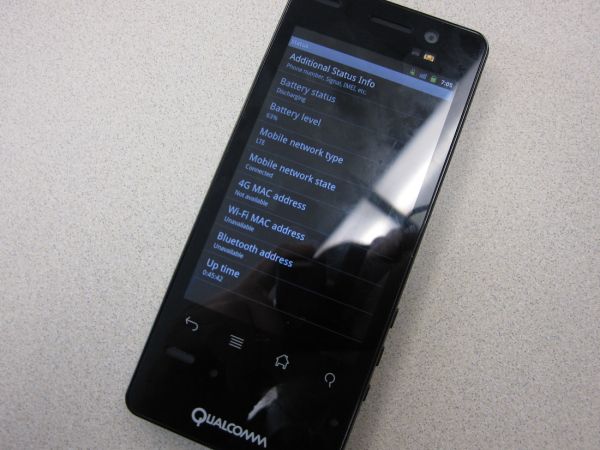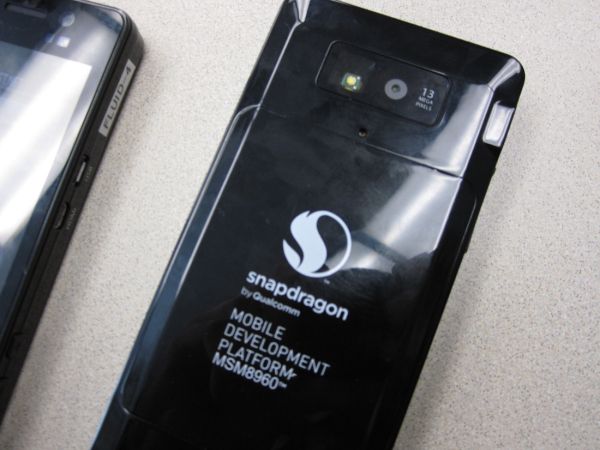Qualcomm's New Snapdragon S4: MSM8960 & Krait Architecture Explored
by Brian Klug & Anand Lal Shimpi on October 7, 2011 12:35 PM EST- Posted in
- Smartphones
- Snapdragon
- Arm
- Qualcomm
- Krait
- MDP
- Mobile
- SoCs
MSM8960 Cellular Connectivity
Until now, to get 4G LTE connectivity in a smartphone has required using two basebands - one for delivering 4G LTE connectivity, and a more traditional smartphone-geared baseband for voice on 2G and 3G data. Take Verizon’s 4G LTE smartphone lineup for example, where many devices combine MSM8655 for camping a 1x voice session alongside MDM9600 for EVDO and LTE, or some other similar combination. Further, all those LTE basebands are built on 45nm process and really geared towards data specific applications.
For a while now we’ve also been talking about 28nm LTE basebands, and specifically the multimode connectivity on MSM8960. This is the first of Qualcomm’s S4 SoCs, and includes 4G LTE connectivity alongside the usual assortment of WCDMA/GSM/CDMA2000 standards. MSM8960’s cellular baseband is based around Qualcomm’s second generation (3GPP Rel.9) LTE modem, which is exactly what’s inside MDM9x15 which we’ve talked about in the past.
The full laundry list of what air interfaces MDM8960 supports is impressive - LTE FDD/TDD, UMTS, CDMA, TD-SCDMA (for Chinese markets), and GERAN (GSM/EDGE). I’ve made a small table below which gives the full laundry list.
| Snapdragon S4 - MSM8960 Cellular Support | |
| LTE FDD | 100 Mbps DL / 50 Mbps UL (Cat. 3, 3GPP Rel.9) |
| LTE TDD | 68 Mbps DL / 17 Mbps UL (Cat. 3, 3GPP Rel.9) |
| UMTS | DC-HSPA+ 42 Mbps DL (Cat. 24) / 11 Mbps UL (Cat. 8) |
| CDMA2000 | 1xAdvanced, EVDO Rev.B (14.7 Mbps DL / 5.4 Mbps UL) |
| GSM | GSM/GPRS/EDGE |
| TD-SCDMA | TD-SCDMA 4.2 Mbps DL / 2.2 Mbps UL |
What’s new again is inclusion of a category 3, 4G LTE baseband into the SoC alongside DC-HSPA+ and TD-SCDMA for the Chinese market. This is a substantial increase in the number of air interfaces supported onboard the SoC which will enable tighter integration and lower power from the baseband being manufactured on that same 28nm process. There’s still the requirement for external RF and transceiver (using RTR8600 or something similar) which houses all the analog, but that’s the same everywhere else.
Since the baseband in MSM8960 is shared with MDM9x15, the two are both 3GPP Release 9 devices, whereas presently MDM9600 and other launch LTE devices are 3GPP Release 8, which was the launch standard. This newer 3GPP release brings a number of improvements, and closer to transitioning to Voice over LTE (VoLTE) and SRVCC (single radio voice call continuity) for fallback to GSM/UMTS or 1x voice in the circumstance that 4G LTE coverage fades. The present combination of a camped 1x voice session alongside 4G LTE for data is also possible in MDM8960, which is exactly what’s done in the case of the HTC Thunderbolt.
In time, carriers will transition to using VoLTE and enrich the voice experience by offering services that work across the data session, alongside some circuit switched (CS) traditional 2G/3G voice to fall back to. For CDMA networks that’ll continue being the dual RF scenario which uses 1x for voice, and for UMTS networks that’ll be a SRVCC augmented fast handover to 3G for voice calls. This handover and call setup is targeted to take place in under one second.
There’s more to the connectivity situation as well, as MSM8960 includes built in WLAN 802.11b/g/n (single spatial stream), Bluetooth, and GPS. These are integrated directly into the MSM8960 the same way the cellular modem is and only require some external RF to use.
Of course, it’s one thing to talk about all this connectivity on MSM8960 and something else entirely to see it. With MSM8660, Qualcomm gave us one of their Mobile Development Platforms (MDPs) which is something of a reference design and development board for each SoC generation.
This time was no exception, and they showed off their new MSM8960 MDP connected to Verizon’s 4G LTE network streaming 1080p YouTube video, loading pages, and finally running a few speedtests using the Speedtest.net application.
This was all over Verizon’s 4G LTE network at Qualcomm HQ in San Diego and worked impressively well for hardware and software that still isn’t production level. In spite of marginal signal in the room we performed testing in, the MDP finished tests with pretty decent results. I ran some more tests on a Droid Bionic in the same room and saw similar results.
Final Words
Qualcomm has had MSM8960 silicon back in house for the past 3 months and is on-track for a release sometime in the first half of next year. Assuming Qualcomm can deliver on its claims, performance alone would be enough to sell this chip. Improved power characteristics and integrated LTE baseband really complete the package though.
The implications for a 1H 2012 MSM8960 release are tremendous. Android users will have to choose between a newer software platform (OMAP 4 running Ice Cream Sandwich) or much faster hardware (MSM8960). Windows Phone users may finally get a much needed performance boost if Microsoft chooses to standardize on Krait for its Windows Phone hardware refresh next year. End users will benefit as next year's smartphones and tablets will see, once again, a generational performance improvement over what's shipping today. LTE should also start to see much more widespread adoption (at the high end) as a result of Qualcomm's integrated LTE baseband.












108 Comments
View All Comments
dagamer34 - Friday, October 7, 2011 - link
Great stuff to look forward to. Some comments:1) I wasn't aware that Microsoft released DirectX 9.3. Perhaps you meant 9.0c or 9.1?
2) Why is nVidia still using a single LPDDR2 channel when everyone else has gone to dual channel memory?
I do look forward to seeing what the next generation of GPUs will provide. Seems like we've stayed in this console generation too long with cell phones having graphics nearly on par with their 200W cousins.
A5 - Friday, October 7, 2011 - link
Re: DX 9.3, you beat me to it.Ilomilo is pretty, but it's not exactly Gears or Battlefield, you know?
Ryan Smith - Friday, October 7, 2011 - link
It's actually more complex than that. When it comes to programming for Direct3D11, there are a number of different GPU feature level targets. The idea is that developers will write their application in DX11, and then have customized render backends to target each feature level they want to hit.As it stands there are 6 feature levels: 11, 10_1, 10, 9_3, 9_2, and 9_1. Unfortunately everyone has been lax in their naming standards; DirectX and Direct3D often get thrown around interchangeably, as do periods and underscores in the feature levels (since prior to D3D 11, we'd simply refer to the version of D3D). This is how you end up with DirectX 9.3 and all permutations thereof. The article has been corrected to be more technically accurate to clear this up.
In any case, 9_1 is effectively identical to Direct3D 9.0. 9_3 is somewhere between D3D 9.0b and 9.0c; it implements a bunch of extra features like multiple render targets, but the shader language is 2.x (Vertex Shader 2.0a, Pixel Shader 2.0b) rather than 3.0
partylikeits1999 - Saturday, October 8, 2011 - link
Microsoft made such a mess out of its DirectX nomenclature in the DX9 timeframe that the rest of the industry started to ignore it and invent their own. Hardly anybody even bothers to distinguish between Direct3D and DirectX anymore...they're used interchangeably, even though the former is a subset of the latter.Windows 8 requires Shader Model 3.0 to be supported by the hardware. Whether you call that 10Level9_3 or 9_3, or DX9.3, or D3D9.3, who cares...from a graphics perspective, it is all just Shader Model 3.0 in the end, whatever you want to call it. All of the Windows 8 launch chipsets from nVidia, TI and Qualcomm, including this MSM8960 will all support Shader Model 3.0 as far as I can tell.
ET - Sunday, October 9, 2011 - link
Feature level 9_3 isn't the same as Shader Model 3 support. The Qualcomm docs say DX9.3 though, which is quite confusing since it doesn't exist. That said, I agree with your assessment that it means Shader Model 3, and not feature level 9_3.felixyang - Saturday, October 8, 2011 - link
2) I believe dual channels don't give any advantage due to tegra's system bus.metafor - Friday, October 7, 2011 - link
MSM8260 and MSM8660 only have single-channel 32-bit LP-DDR2 memory, not dual.z0mb13n3d - Friday, October 7, 2011 - link
Please read:Although Scorpion featured a dual-channel LPDDR2 memory controller, in a PoP configuration only one channel was available to any stacked DRAM. In order to get access to both 32-bit memory channels the OEM had to implement a DRAM on-package as well as an external DRAM on the PCB. Memory requests could be interleaved between the two DRAM, however Qualcomm seemed to prefer load balancing between the two with CPU/GPU accesses being directed to the lower latency PoP DRAM. Very few OEMs seemed to populate both channels and thus Scorpion based designs were effectively single-channel offerings.
I can tell you with a modicum of confidence that this is true, at least partially.
Aren't you the same person who went on (ranting, obviously) about Krait using HKMG and hitting 2.5GHz next year, in another article?
ArunDemeure - Friday, October 7, 2011 - link
I suggest you stop embarassing yourself. metafor knows what he's talking about, and you clearly don't. I read that previous thread - he was pretty much spot on for everything, as you would expect. I honestly don't know why he even bothers here given the reception he's getting...Anyway unlike what the article says, the MSM8x60 indeed only has single-channel 32-bit LPDDR2. However there's a twist: Qualcomm offers it in a PoP (Package-on-Package) configuration at up to 266MHz or an 'ISM' (i.e. SiP or System-in-Package) at up to 333MHz. I wouldn't be surprised if many OEMs used the PoP for cost reasons.
I think the confusion might come from another (older) Qualcomm SoC working like the article described iirc, but this does not apply to the MSM8x60 AFAIK.
Anand Lal Shimpi - Friday, October 7, 2011 - link
Arun,This information does come from Qualcomm, although the odd PoP + external DRAM configuration (that no one seems to use) basically means that MSM8x60 is a single-channel architecture (which is why I starred it in the table above). I will ask Qualcomm once more for confirmation that this applies to MSM8x60 as well as the older single core variants.
Take care,
Anand